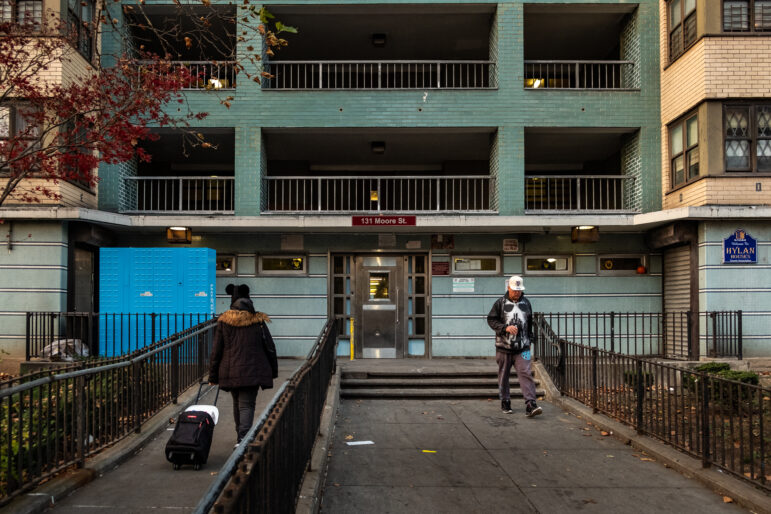Voter registration drives have been a popular backbone of activist community politics for years.
But until now, voter turnout has nearly always been left to candidates’ operations and their
supporters.
In an organizing experiment that culminated on Election Day, a network of New York City
community organizations showed that mobilizing turnout among a new constituency of voters is
a potentially powerful way to draw attention to long-ignored neighborhoods.
Eight New York City community groups, affiliates of the Industrial Areas Foundation (IAF), the
nation’s oldest community organizing network, got 23,000 people in parts of Manhattan,
Brooklyn, Queens and the Bronx to pledge they would vote, according to David Fleischer, who
headed up the project. The groups hope to get 50,000 voters to the polls for the mayoral election
next year, he says.
The experiments appear to have paid off. One member group, East Harlem Partnership for
Change, collected 7,000 vote pledges from members, and West Siders Together (WEST) pulled
out about 3,300. The groups used a legion of neighborhood residents to work as “captains,”
ensuring that those who pledged to vote actually made it to the polls.
For Altagracia Hiraldo, one of WEST’s 75 captains, that meant working 15 hours straight to hold
200 of her fellow parishioners to their promise to come out and pull the lever. The evening of
Election Day, she had her hard work affirmed by her pastor, an enthusiastic supporter of
WEST’s voter mobilization. Celebrating mass at the Church of the Ascension on West 107th
Street, Father John Dufell explained that the Catholic faith demands more than just attending
weekly worship-it also means becoming involved in your communities, working for social
justice.
Hiraldo-who emigrated from the Dominican Republic 15 years ago but only recently became a
citizen-offers a blunter version of her pastor’s message: “You have to demonstrate your faith
through action, not just pray, pray, pray. You have to do something for others, for poor people.
He said how important it is to vote, because we can change our society.”
First Foray
This was the local IAF affiliates’ first foray into electoral politics. Yet for years, the groups have
been fostering community leadership from among their member institutions, including churches,
synagogues, block associations and other organizations. WEST, for example, has worked with
local residents on crime, education and transportation issues.
The nonpartisan IAF does not plan to endorse candidates. Instead, leaders hope to force
politicians of all stripes to pay as much attention to low- and moderate-income neighborhoods as
they do to the city’s affluent communities-which are, not coincidentally, known for high voter
turnout rates. This way, IAF organizers reason, they can shape political agendas from the get-go.
“Obviously, if a neighborhood is heavily registered or has shown a recent spurt in voting activity,
that would come to the attention of a candidate,” says Manhattan Borough President Ruth
Messinger, who has all but declared her plans to run for mayor. “I’m sure they’re going to be a
factor,” she adds. “I expect they will have an impact on who votes and on how they vote in ’97.”
The IAF affiliates (which also include Queens Citizens Organization, South Bronx Churches,
Harlem Initiatives Together, Brooklyn Interfaith for Action and Central Brooklyn Churches)
used varying approaches in this year’s voter drive, says Fleischer. In some cases, captains
targeted people in their member congregations and institutions. In others, he says, they opted for
a geographic focus, canvassing neighbors who live in their housing projects or on their block. In
still others, captains talked to everyone they knew.
WEST captains began by working their congregations, but a few weeks prior to Election Day
they started going door to door in their buildings as well, says lead organizer Vonda Brunsting.
“They could say, ‘I know exactly where you can vote, because I vote in the same place,’ ” she
explains. And they could judge their effectiveness by checking turnout in districts where they had
canvassed.
Infectious Enthusiasm
Bessie Fontenez, a captain in East Harlem, spent Election Day walking back and forth between
polling places near Lexington Avenue and 114th Street, where she was born 50 years ago and
still lives. She is just one example of IAF’s plan to create a new roster of fired-up leaders that will
get out the vote year after year.
Her two foster daughters in tow, Fontenez enthusiasm was infectious. She did not let a single
individual pass by on the street without giving them a friendly reminder-in English, Spanish or
both-to vote.
“Here come some more of my ladies,” she said as some neighbors approached. “I’m very
happy.”








